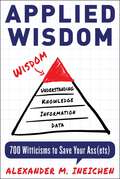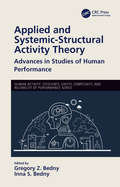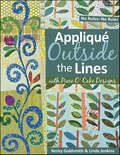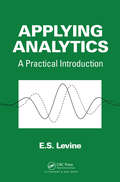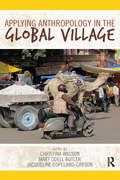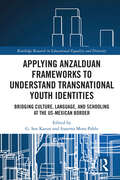- Table View
- List View
Applied Wisdom: 700 Witticisms to Save Your Assets
by Alexander IneichenApplying wisdom and avoiding foolishness are two sides of the same coin. Slipping away from either can lead to risky and uncertain situations. Luckily, author Alexander Ineichen has been collecting witticisms for thirty-five years that have made him successful in his career and life. In Applied Wisdom, he collects an anthology of wit and wisdom containing over 700 quotations from sources as wide ranging as Thomas Aquinas and Frank Zappa. He provides entertaining food for thought for businesspeople and the general audience alike, and enables readers to think outside the box to find wisdom. These nuggets, along with his commentary for each, are the valuable words needed for those facing risk and uncertainty. The witticisms provide a full range of being level-headed, truth seeking, brutally heretical, wonderfully insightful, refreshingly politically incorrect, and other intellectual treats and provocations. The advice, blending economics, politics, history, philosophy, psychology, risk management, and much more, provides a winning mix of humor, intellectual heft, and economic survival tips.
Applied Yoga™ for Musculoskeletal Pain: Integrating Yoga, Physical Therapy, Strength, and Spirituality
by Jory SerotaThis innovative and evidence-based book provides practical and transformative guidance on how to help clients struggling with chronic and acute musculoskeletal pain through yoga and remedial exercise. Using a holistic framework that addresses the physical, mental and emotional challenges of chronic pain, Jory Serota offers a wide range of tools yoga therapists and bodyworkers can use to empower clients and help them work with their bodies intuitively.It includes photographs with step-by-step instructions for practice, all of which include adaptations to meet a range of ability and mobility. Common areas of chronic pain are discussed in depth, including the lower back, knees, hips, sacroiliac joint and glutes, shoulders, and neck, allowing practitioners to address specific concerns and maximise healing.Practitioners will benefit from full yoga sequences and will be able to expand their offering by practically and confidently addressing the widespread struggle of chronic musculoskeletal pain.
Applied and Clinical Sociology in Aotearoa New Zealand (Clinical Sociology: Research and Practice)
by Zarine L. Rocha Kathy L. DavidsonThis is the first volume to explore clinical and applied sociology in Aotearoa New Zealand, while also providing unique insights into the practice of sociology internationally. Drawing out the intersections between sociological research, public sociology and applied sociology, the chapters in this volume enrich the rapidly growing field of international clinical sociology. Aotearoa New Zealand presents an important case study in the development and practice of sociology: with a vibrant social scientific community and a significant diversity of scholars and practitioners, local research and practice highlight the country’s innovative and often unusual approaches to addressing social problems. This volume brings together a diversity of scholars and practitioners, from the country’s top sociologists to early career researchers, and provides a comprehensive and valuable exploration of sociology and its many practical applications in this unique context. It covers a wide range of key topics in the field, from the challenges of practicing a public sociology in Aotearoa New Zealand to the role of applied and clinical sociologists in government and consultancies. Contemporary social issues are explored as case studies, including practising sociological psychotherapy; indigenous applications of sociology and Māori language learning; and applying sociology within healthcare. This is a key addition to applied and clinical sociology literature.
Applied and Computational Mathematics: ICoMPAC 2023, Sukolilo, Indonesia, September 30 (Springer Proceedings in Mathematics & Statistics #455)
by Dieky Adzkiya Kistosil FahimThis book collects selected, peer-reviewed research presented at the 8th International Conference on Mathematics: Pure, Applied, and Computation, held in Lombok, Indonesia, on 30 September 2023. Organised into three parts—Part I: Control Systems, Mathematical Simulation and Modeling; Part II: Formal Methods and Data Science; Part III: Graph Theory and Analysis—the book contains 29 peer-reviewed chapters. Ranging from theoretical to applied results, the book addresses the mathematical models for several phenomena such as investment behavior, unmanned surface vehicles and electronic medical records. It also highlights the progress in the use of satisfiability methods and tools to solve puzzle and pencil games. It showcases how mathematics is used to solve real-world problems.
Applied and Computational Matrix Analysis: MAT-TRIAD, Coimbra, Portugal, September 2015 Selected, Revised Contributions (Springer Proceedings in Mathematics & Statistics #192)
by Natália BebianoThis volume presents recent advances in the field of matrix analysis based on contributions at the MAT-TRIAD 2015 conference. Topics covered include interval linear algebra and computational complexity, Birkhoff polynomial basis, tensors, graphs, linear pencils, K-theory and statistic inference, showing the ubiquity of matrices in different mathematical areas. With a particular focus on matrix and operator theory, statistical models and computation, the International Conference on Matrix Analysis and its Applications 2015, held in Coimbra, Portugal, was the sixth in a series of conferences. Applied and Computational Matrix Analysis will appeal to graduate students and researchers in theoretical and applied mathematics, physics and engineering who are seeking an overview of recent problems and methods in matrix analysis.
Applied and Computational Optimal Control: A Control Parametrization Approach (Springer Optimization and Its Applications #171)
by Bin Li Kok Lay Teo Changjun Yu Volker RehbockThe aim of this book is to furnish the reader with a rigorous and detailed exposition of the concept of control parametrization and time scaling transformation. It presents computational solution techniques for a special class of constrained optimal control problems as well as applications to some practical examples. The book may be considered an extension of the 1991 monograph A Unified Computational Approach Optimal Control Problems, by K.L. Teo, C.J. Goh, and K.H. Wong. This publication discusses the development of new theory and computational methods for solving various optimal control problems numerically and in a unified fashion. To keep the book accessible and uniform, it includes those results developed by the authors, their students, and their past and present collaborators. A brief review of methods that are not covered in this exposition, is also included. Knowledge gained from this book may inspire advancement of new techniques to solve complex problems that arise in the future. This book is intended as reference for researchers in mathematics, engineering, and other sciences, graduate students and practitioners who apply optimal control methods in their work. It may be appropriate reading material for a graduate level seminar or as a text for a course in optimal control.
Applied and Systemic-Structural Activity Theory: Advances in Studies of Human Performance (Human Activity)
by Gregory Z. Bedny Inna S. BednyThis book presents new data in Applied Activity Theory (AAT) and Systemic-Structural Activity Theory (SSAT), that can be used in the study of human performance. The SSAT is the high-level generality theory that offers standardized principles of the analyses of human activity. These principles can be utilized in theoretical and applied studies. This multi-contributed book offers a selection of works that will provide a holistic picture of the field. The new data can be utilized for the study of extremely complex human-machine and human-computer interaction systems, and for evaluation of efficiency, complexity, and reliability of such systems at the design stage. Features Shows examples of self-regulative models of various cognitive processes Illustrates a method of study of production process in the construction industry Includes topics on learning, training, and management Covers a new method of computer based automated support of decision making under risk and uncertainty Presents a new method of evaluation of probabilistic structure of tasks, and the method of assessing reliability of human performance
Applied equine nutrition and training: Equine NUtrition and TRAining COnference (ENUTRACO) 2011
by Arno LindnerThis book contains specialised information on the nutrition and training of the horse. Practical hints can be drawn from studies showing how apes indicate to us plants which have medicinal properties that can then be applied to equine treatment and also have an effect in nutraceuticals. Overviews are given on the potential of total mixed rations for the future of horse feeding and the practical feeding of obese horses and ponies. Nutrition considerations are given to avoid medical conditions. Methods used for performance diagnosis and training guidance of human athletes are applied here to equine management. In addition, training techniques which reduce the risk of back injury in the horse are explored and a review of the riders interaction with the horse is provided. Practical nutritional information acquired through research is applied to all aspects of managing endurance racehorses. Finally, expanded abstracts of original research are provided in very diverse fields of nutrition and training of horses. All those concerned with training, riding and feeding in the equine industry will benefit from the contents.
Applied ethics and social problems: Moral questions of birth, society and death
by Tony FitzpatrickDesigned to address practical questions, applied ethics is one of the most exciting areas in contemporary philosophy. Yet the relevance of ethical theories to social policy has been under-explored. Until now. In Applied ethics and social problems Tony Fitzpatrick presents introductions to the three most influential moral philosophies: Consequentialism, Kantianism and Virtue Ethics. He then relates these to some of the most urgent questions in contemporary public debates about the future of welfare services. These include taxing unhealthy habits, drug legalisation, parental choice in education, abortion, euthanasia and migration & cultural diversity. In each case he asks a perennial question: what are the legitimate boundaries of state action and individual liberty? Never before has there been such a rigorous overview of the topic offered to social policy students, academics and professionals, as well as those interested in public policy, politics and social science. A user-friendly intervention into these key debates Applied ethics and social problems will set the agenda for years to come.
Appliqué Outside Lines with Piece O' Cake Designs
by Becky Goldsmith Linda JenkinsPut Down the Ruler and Free Your Inner Appliqué Artist • Create 8 expressive appliqué quilts with this foolproof, no-rules approach • Make your quilts as precise or freewheeling as you want them to be • Use fabric color and value to make your appliqué come alive Who says beautiful appliqué has to be fussy? Learn to create fresh and free quilts with your rotary cutter and new improvisational techniques from Piece O' Cake Designs. *Important Note about PRINT ON DEMAND Editions: This title will be printed after purchase and will arrive separately from any in-stock items. Please allow approximately 2 weeks for USA delivery, with an additional 2 weeks for international shipments. Expedited shipping is not available on POD Editions. The printing quality in this copy will vary from the original offset printing edition and may look more saturated due to printing on demand by a high-quality printer on uncoated (non-glossy) paper. The information presented in this version is the same as the most recent printed edition. Any pattern pullouts have been separated and presented as single pages.
Appliqué Petal Party
by Susan Brubaker KnappCelebrate the Beauty of Flowers with Appliqué • 16 wonderful 12 1/2" bouquet blocks and floral border make a 73" x 73" finished quilt • Make the whole quilt or use one block as a pillow or wall hanging • Package includes needle-turn appliqué basics and step-by-step instructions for the project quilt • Full-size, easy-to-use appliqué patterns Celebrate the beauty of flowers with this festive floral appliqué quilt. The package includes instructions and photos of a variety of other color and fabric options, including wool appliqué.
Appliqué Workshop: Mix & Match 10 Techniques to Unlock Your Creativity
by Laurel AndersonYour Complete Reference For All Things Appliqué • A comprehensive workbook on the most popular appliqué techniques • Plenty of photos and illustrations to help you along the way, plus a gorgeous gallery of quilts and other projects • Learn how to choose appliqué techniques with confidence for the perfect quilt, every time • Give new life to your quilts with design principles that engage the eye
Appliqué with Attitude from Piece O'Cake Designs: 10 Projects Featuring Big, Bold Stitches
by Becky Goldsmith Linda Jenkins“The bright colored fabrics used throughout and the whimsical patterns make this a delightful read” from the bestselling design team (The Applique Society).Does your appliqué need a little attitude adjustment? Becky Goldsmith and Linda Jenkins of Piece O’ Cake Designs come to your rescue with creative new projects using bold stitching in contrasting colors of perle cotton thread. Mix & match full-size templates for bright, cheerful quilts and home décor. Give tradition a little twist and add a happy, carefree layer of color and texture to your work. Use this quick needleturn technique to add a touch of whimsy to anything you appliqué. You’ll love making these chirpy birds, doodly daisies, and sweet tulips with your favorite fresh fabrics.“The dynamic duo behind the Piece O’ Cake brand have experimented with a style of applique that is new to them in this collection of 10 projects . . . they decided to have a go working with large, bold stitches in colors that often contrast with the fabric. The projects they’ve included are all small—cushions, tea towels, wallhangings—so there’s ample opportunity to choose one and give this method a whirl.” —Australian Homespun Magazine
Apply Data Science: Introduction, Applications and Projects
by Thomas Barton Christian MüllerThis book offers an introduction to the topic of data science based on the visual processing of data. It deals with ethical considerations in the digital transformation and presents a process framework for the evaluation of technologies. It also explains special features and findings on the failure of data science projects and presents recommendation systems in consideration of current developments. Machine learning functionality in business analytics tools is compared and the use of a process model for data science is shown.The integration of renewable energies using the example of photovoltaic systems, more efficient use of thermal energy, scientific literature evaluation, customer satisfaction in the automotive industry and a framework for the analysis of vehicle data serve as application examples for the concrete use of data science. The book offers important information that is just as relevant for practitioners as for students and teachers.
Apply Within: Stories of career sabotage
by Michaela McGuireWhen Michaela McGuire was hired by a federal MP eight months before the 2007 election, she didn't know exactly what to expect. She probably should have, because before that she had worked in the highrollers' room of a casino and had overseen lap dances in a strip club. It would become another novelty job to add to her brief but colourful r�sum�.Michaela has advised a Liberal MP to campaign for his seat rather than get a haircut, cleaned ashtrays and helped organise a senior partner's stamp collection at a prestigious law firm. Whatever the contributing factors to her brilliant career, foresight was not one of them.
Applying AI-Based Tools and Technologies Towards Revitalization of Indigenous and Endangered Languages (Studies in Computational Intelligence #1148)
by Satya Ranjan Dash Shantipriya Parida Sushree Sangita MohantyThis book emphasises the need for language resource development and its impact on society. It covers latest AI based tools and techniques used to preserve indigenous and endangered languages. The book also highlights latest AI based technologies such as Generative Pre-trained Transformer (GPT) towards endangered language preservation. It discusses morphology analysis, translation support and shallow parsing of various tribal languages of India and abroad. This book tries to answer how digital technologies can make language revitalization accessible to future generations.
Applying APL Principles in Flexible Assessment: A Practical Guide
by Cook, Cathy Simosko, SusanAccreditation of prior learning (APL) is a key component of the current drive towards competence-based education and training. The author, in this edition, emphasizes that APL is part of the continuum of learning, not a stand-alone assessment service.
Applying Advanced Information Systems To Ports And Waterways Management
by National Research CouncilThe future safety of maritime transportation in the United States-a major factor in the nation's international trade and economic well-being-will depend heavily on the quality of port and waterways information systems. <P><P>Many U.S. ports and waterways lack adequate information services, although certain elements of advanced systems are now available in some locations. Barriers to improvements in information systems include the division of responsibilities for waterways management among multiple agencies at all levels of government, a lack of coordination among the federal agencies responsible for waterways management, inadequate budgets for some critical maritime programs, the high costs of some specialized technologies, stakeholder opposition to user fees, limited access to certain key data, the incompatibility of many independently developed systems, and the absence of standards for some attractive technologies.
Applying Analytics: A Practical Introduction
by E. S. LevineNewcomers to quantitative analysis need practical guidance on how to analyze data in the real world yet most introductory books focus on lengthy derivations and justifications instead of practical techniques. Covering the technical and professional skills needed by analysts in the academic, private, and public sectors, Applying Analytics: A Practic
Applying Anthropology in the Global Village
by Mary Odell Butler Jacqueline Copeland-Carson Christina WassonThe realities of the globalized world have revolutionized traditional concepts of culture, community, and identity—so how do applied social scientists use complicated, fluid new ideas such as translocality and ethnoscape to solve pressing human problems? In this book, leading scholar/practitioners survey the development of different subfields over at least two decades, then offer concrete case studies to show how they have incorporated and refined new concepts and methods. After an introduction synthesizing anthropological practice, key theoretical concepts, and ethnographic methods, chapters examine the arenas of public health, community development, finance, technology, transportation, gender, environment, immigration, aging, and child welfare. An innovative guide to joining dynamic theoretical concepts with on-the-ground problem solving, this book will be of interest to practitioners from a wide range of disciplines who work on social change, as well as an excellent addition to graduate and undergraduate courses.
Applying Anthropology to General Education: Reshaping Colleges and Universities for the 21st Century
by Jennifer R. WiesThe current higher education policy and practice landscape is simultaneously marked by uncertainty and hope, and nowhere are these tensions more present than in discussions and actions around general education. This volume uses an anthropological approach to contemplate ways of reimagining general education for the 21st century and how faculty, teachers, administrators, and others can transform the educational endeavor to be holistic, comprehensive, and aligned with the needs of people and the planet in the decades to come. Included are analyses of general education concepts such as "diversity," case studies of general education and connecting curricula, opportunities for faculty development, unique general education student populations, assessment strategies, and philosophical/pedagogical challenges. Contributors make the case that far from receding from a central role in higher education, there is a need to strengthen general education curricula as key to the educational needs of students, for the skills and competencies they require in the workplace and for civic engagement.
Applying Anzalduan Frameworks to Understand Transnational Youth Identities: Bridging Culture, Language, and Schooling at the US-Mexican Border (Routledge Research in Educational Equality and Diversity)
by G. Sue Kasun Irasema Mora-PabloFramed by the theoretical work of Gloria Anzaldúa, this volume focuses on the cultural and linguistic practices of Mexican-origin youth at the U.S. border to explore how young people engage in acts of "bridging" to develop rich, transnational identities. Using a wealth of empirical data gathered through interviews and observations, and featuring perspectives from multinational and transnational authors, this text highlights how youth resist racialized and raciolinguistic oppression in both formal and informal contexts by purposefully engaging with their heritage culture and language. In doing so, they defy deficit narratives and negotiate identities in the "in-between." As a whole, the volume engages issues of identity, language, and education, and offers a uniquely asset-based perspective on the complexities of transnational youth identity, demonstrating its value in educational and academic spaces in particular. This text will benefit researchers, academics, and educators with an interest in the sociology of education, multicultural education, and youth culture more broadly. Those interested in language and identity studies, as well as adolescence, schooling, and bilingualism, will also benefit from this volume.
Applying Artificial Intelligence in Cybersecurity Analytics and Cyber Threat Detection
by Vania Vieira Estrela Mehak Khurana Shilpa MahajanAPPLYING ARTIFICIAL INTELLIGENCE IN CYBERSECURITY ANALYTICS AND CYBER THREAT DETECTION Comprehensive resource providing strategic defense mechanisms for malware, handling cybercrime, and identifying loopholes using artificial intelligence (AI) and machine learning (ML) Applying Artificial Intelligence in Cybersecurity Analytics and Cyber Threat Detection is a comprehensive look at state-of-the-art theory and practical guidelines pertaining to the subject, showcasing recent innovations, emerging trends, and concerns as well as applied challenges encountered, and solutions adopted in the fields of cybersecurity using analytics and machine learning. The text clearly explains theoretical aspects, framework, system architecture, analysis and design, implementation, validation, and tools and techniques of data science and machine learning to detect and prevent cyber threats. Using AI and ML approaches, the book offers strategic defense mechanisms for addressing malware, cybercrime, and system vulnerabilities. It also provides tools and techniques that can be applied by professional analysts to safely analyze, debug, and disassemble any malicious software they encounter. With contributions from qualified authors with significant experience in the field, Applying Artificial Intelligence in Cybersecurity Analytics and Cyber Threat Detection explores topics such as: Cybersecurity tools originating from computational statistics literature and pure mathematics, such as nonparametric probability density estimation, graph-based manifold learning, and topological data analysisApplications of AI to penetration testing, malware, data privacy, intrusion detection system (IDS), and social engineeringHow AI automation addresses various security challenges in daily workflows and how to perform automated analyses to proactively mitigate threatsOffensive technologies grouped together and analyzed at a higher level from both an offensive and defensive standpoint Providing detailed coverage of a rapidly expanding field, Applying Artificial Intelligence in Cybersecurity Analytics and Cyber Threat Detection is an essential resource for a wide variety of researchers, scientists, and professionals involved in fields that intersect with cybersecurity, artificial intelligence, and machine learning.
Applying AutoCad 2008
by Terry T. WohlersApplying AutoCAD 2008introduces new features and enhancements to existing capabilities. What's New in 2008? * A new default workspace called 2DDrafting & Annotationhas been added. * The new 2D Drafting and Annotation workspace employs a new Dashboard containing panels and toolbars for drawing and dimensioning in two dimensions, while new panels and features improve the Dashboard for the 3D Modeling workspace. * New dimensioning capabilities are introduced, including a new Multileader tool and easy alignment and spacing control of dimension lines. * New commands and features to control drawing annotations are added to simplify and improve Multiline text, text styles, tables, and the creation of bill of materials.
Applying Behavioural Science to the Private Sector: Decoding What People Say and What They Do
by Helena RubinsteinThis book demonstrates how applying behavioural science to commercial problems can effectively help businesses to understand and achieve the best outcomes for their customers. Bringing together theory and practice the author describes how approaches underpinning behavioural science can be adapted to the fast-moving environment of the private sector. The first part of the book discusses the underlying theory and principles behind behavioural science. It outlines the history of the discipline, explaining how behavioural scientists use theories and models of behaviour, and discussing why behaviour is so hard to predict. It then describes how the theory can be applied to designing products, services and interventions. In Part II Rubinstein uses several key case studies to explore the challenges of integrating behavioural science into established practices, considering how to use behavioural science in multidisciplinary teams and why this might be useful. She addresses concerns about the ethics of using behavioural science in this context before describing the value of applying behavioural science to business and how best to realise its potential. This book is a must-read for both practitioners and academics interested in applying the science of behaviour to real-world challenges.
